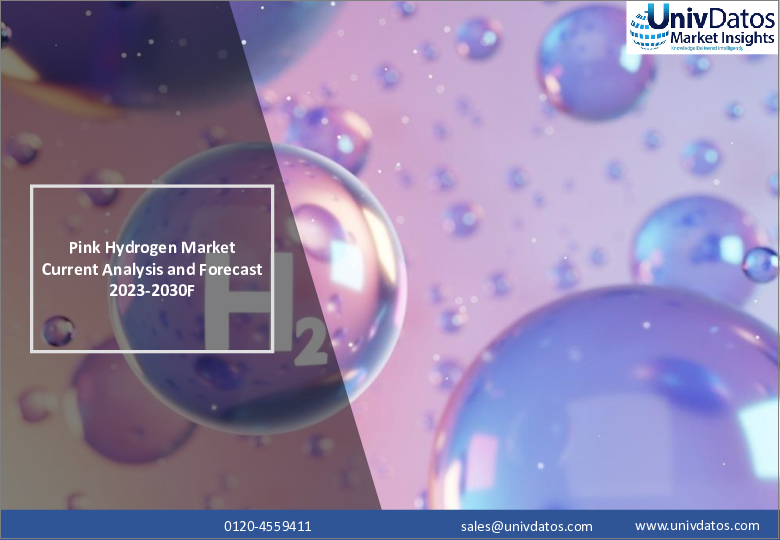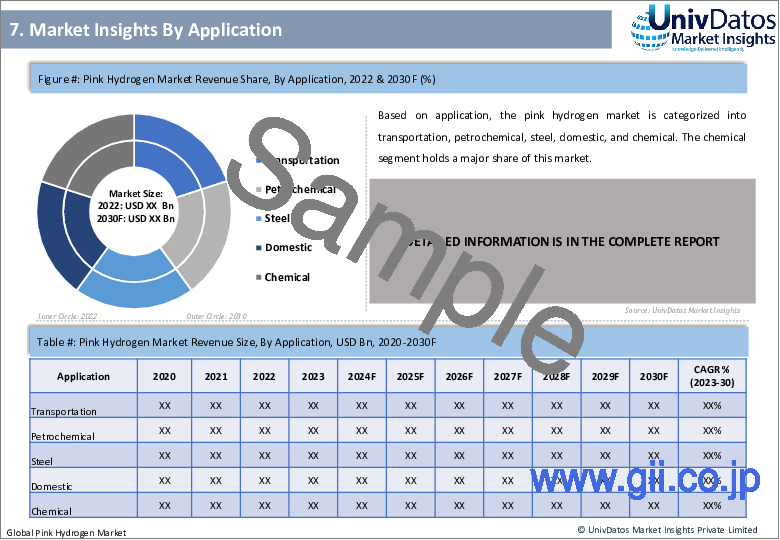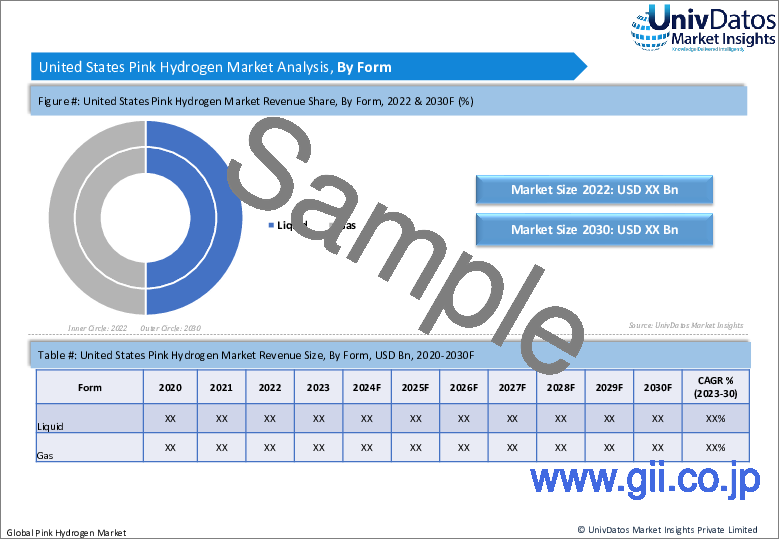|
|
市場調査レポート
商品コード
1408686
ピンク水素市場:現状分析と予測(2023年~2030年)Pink Hydrogen Market: Current Analysis and Forecast (2023-2030) |
||||||
カスタマイズ可能
|
|||||||
| ピンク水素市場:現状分析と予測(2023年~2030年) |
|
出版日: 2023年12月30日
発行: UnivDatos Market Insights Pvt Ltd
ページ情報: 英文 143 Pages
納期: 即日から翌営業日
|
全表示
- 概要
- 目次
ピンク水素は、原子力エネルギーによる水の電気分解を使用して生成される水素の一種です。CO2を排出しないため、環境に優しいと考えられており、グリーンであることが知られています。ピンク水素は、セメント、鉄鋼、航空、重量輸送などの多くの業界で化石燃料の有望な代替品となりつつあります。温室効果ガスを排出せずに原料およびエネルギー源として使用できます。原子力発電によって生成されるグリーン水素は、従来の方法と比較して、生成コストや排出量の削減などのいくつかの利点があり、より持続可能で費用対効果の高い代替手段となります。さらに、主要企業はピンク水素の製造研究開発に投資しており、市場の成長がさらに加速しています。
ピンク水素市場は、その形態から液体と気体に二分されます。液体セグメントは、予測される数年間で、大きな需要に対応すると予想されます。これは主に、自動車、鉄道、飛行機、船舶に適用される燃料電池に使用される液体水素の需要増加がピンク水素の市場規模を押し上げているためです。
ピンク水素市場は、用途別に輸送、石油化学、鉄鋼、家庭用、化学に分類されます。化学セグメントがこの市場で大きなシェアを占めています。水素は化学およびプラスチック産業の原料であり、アンモニア、メタノール、その他の化学物質の生産に使用されます。
ピンク水素業界の市場導入に関する理解を深めるため、市場は北米(米国、カナダ、その他北米地域)、欧州(ドイツ、英国、フランス、ノルウェー、その他欧州地域)、アジア太平洋地域(中国、オーストラリア、その他アジア太平洋地域)、世界のその他の地域における世界の存在に基づいて分析されます。アジア太平洋地域は、ピンク水素市場において最も高いシェアを占めると予想されます。クリーンエネルギーへの投資の急増やカーボンフットプリントの削減を目指す政府の取り組みなどの要因が、ピンク水素の市場規模を拡大しています。さらに、インド、日本、その他の国々は、需要を満たすために水素の生産を計画しており、ピンク水素市場の成長を加速させています。日本のクリーンエネルギー戦略では、国内の水素需要を2030年に300万トン、2050年に2,000万トンと予測しています。現在、200万トンの水素が石油精製から製品別として生産されています。同戦略は、2050年までに水素の生産量を10倍に増やすことを目指しています。
目次
第1章 市場イントロダクション
- 市場の定義
- 主な目標
- ステークホルダー
- 制限事項
第2章 調査手法または前提
- 調査プロセス
- 調査手法
- 回答者プロファイル
第3章 市場要約
第4章 エグゼクティブサマリー
第5章 ピンク水素市場収益 、2020-2030年
第6章 形状別の市場洞察
- 液体
- ガス
第7章 用途別の市場洞察
- 輸送機関
- 石油化学
- 鋼鉄
- 国内
- 化学薬品
第8章 地域別の市場洞察
- 北米
- 米国
- カナダ
- その他北米地域
- 欧州
- ドイツ
- 英国
- フランス
- スウェーデン
- ロシア
- その他欧州地域
- アジア太平洋
- 中国
- 日本
- インド
- オーストラリア
- その他アジア太平洋地域
- 世界のその他の地域
第9章 ピンク水素市場力学
- 市場促進要因
- 市場の課題
- 影響分析
第10章 ピンク水素市場機会
第11章 ピンク水素市場動向
第12章 需要側と供給側の分析
- 需要側分析
- 供給側分析
第13章 バリューチェーン分析
第14章 競合シナリオ
- 競合情勢
- ポーターのファイブフォース分析
第15章 企業プロファイル
- Siemens Energy AG
- Linde Plc
- Hydrogenics Corporation
- Ballard Power Systems Inc.
- ITM Power plc
- McPhy Energy S.A.
- Nel ASA
- Plug Power Inc.
- Toshiba Energy Systems & Solution Corporation
- Doosan Fuel Cell America
第16章 免責事項
Pink hydrogen is a form of hydrogen produced by using water electrolysis powered by nuclear energy. It is considered environmentally friendly and known to be green due to its non-production of CO2 emissions. Pink hydrogen is becoming a promising alternative to fossil fuels in many industries, including cement, steel, aviation, and heavy transportation. It can be used as a feedstock and energy source without producing any greenhouse gas emissions. Green hydrogen produced through nuclear power has several advantages compared to conventional methods, including reduced production costs and emissions, making it a more sustainable and cost-effective alternative. Furthermore, key players are investing in the production research & and development of pink hydrogen, which is further accelerating its market growth.
For instance, Swedish power company OKG has signed a commercial deal to sell pink hydrogen to industrial gas company Linde Gas, marking the first-ever commercial agreement for nuclear-derived hydrogen. Currently producing 12 kg of pink hydrogen daily, OKG plans to sell excess hydrogen to Linde, with the initial volumes sold being small.
Based on the form, the pink hydrogen market is bifurcated into liquid and gas. The liquid segment is expected to cater to significant demand in the projected years. It is mainly owing to the rising demand for liquid hydrogen used in fuel cells applied in automobiles, rails, planes, and ships is propelling the market size of pink hydrogen.
Based on application, the pink hydrogen market is categorized into transportation, petrochemical, steel, domestic, and chemical. The chemical segment holds a major share of this market. Hydrogen is the feedstock of the chemical and plastic industry and is used in the production of ammonia, methanol, and other chemicals.
For a better understanding of the market adoption of the pink hydrogen industry, the market is analyzed based on its worldwide presence in countries such as North America (U.S., Canada, and the Rest of North America), Europe (Germany, U.K., France, Norway, Rest of Europe), Asia-Pacific (China, Australia, Rest of Asia-Pacific), Rest of World. Asia Pacific is expected to experience the highest share in the Pink Hydrogen market. Factors such as soaring investment in clean energy and government initiatives to decrease carbon footprints are increasing the market size of pink hydrogen. Further, countries such as India, Japan, and others are planning to produce hydrogen to meet the demand accelerating pink hydrogen market growth. Japan's Clean Energy Strategy estimates a domestic hydrogen demand of 3 million tons in 2030 and 20 million tons in 2050. Presently, 2 million tons of hydrogen are produced as by-products from oil refineries. The strategy aims to increase the production of hydrogen by tenfold by 2050.
Some of the major players operating in the market include: Siemens Energy AG, Linde Plc, Hydrogenics Corporation, Ballard Power Systems Inc., ITM Power plc, McPhy Energy S.A., Nel ASA, Plug Power Inc., Toshiba Energy Systems & Solution Corporation, and Doosan Fuel Cell America.
TABLE OF CONTENTS
1 MARKET INTRODUCTION
- 1.1. Market Definitions
- 1.2. Main Objective
- 1.3. Stakeholders
- 1.4. Limitation
2 RESEARCH METHODOLOGY OR ASSUMPTION
- 2.1. Research Process of the Pink Hydrogen Market
- 2.2. Research Methodology of the Pink Hydrogen Market
- 2.3. Respondent Profile
3 MARKET SYNOPSIS
4 EXECUTIVE SUMMARY
5 PINK HYDROGEN MARKET REVENUE (USD BN), 2020-2030F
6 MARKET INSIGHTS BY FORM
- 6.1. Liquid
- 6.2. Gas
7 MARKET INSIGHTS BY APPLICATION
- 7.1. Transportation
- 7.2. Petrochemical
- 7.3. Steel
- 7.4. Domestic
- 7.5. Chemical
8 MARKET INSIGHTS BY REGION
- 8.1. North America
- 8.1.1. U.S.
- 8.1.2. Canada
- 8.1.3. Rest of North America
- 8.2. Europe
- 8.2.1. Germany
- 8.2.2. U.K.
- 8.2.3. France
- 8.2.4. Sweden
- 8.2.5. Russia
- 8.2.6. Rest of Europe
- 8.3. Asia-Pacific
- 8.3.1. China
- 8.3.2. Japan
- 8.3.3. India
- 8.3.4. Australia
- 8.3.5. Rest of Asia-Pacific
- 8.4. Rest of World
9 PINK HYDROGEN MARKET DYNAMICS
- 9.1. Market Drivers
- 9.2. Market Challenges
- 9.3. Impact Analysis
10 PINK HYDROGEN MARKET OPPORTUNITIES
11 PINK HYDROGEN MARKET TRENDS
12 DEMAND AND SUPPLY-SIDE ANALYSIS
- 12.1. Demand Side Analysis
- 12.2. Supply Side Analysis
13 VALUE CHAIN ANALYSIS
14 COMPETITIVE SCENARIO
- 14.1. Competitive Landscape
- 14.1.1. Porters Fiver Forces Analysis
15 COMPANY PROFILED
- 15.1. Siemens Energy AG
- 15.2. Linde Plc
- 15.3. Hydrogenics Corporation
- 15.4. Ballard Power Systems Inc.
- 15.5. ITM Power plc
- 15.6. McPhy Energy S.A.
- 15.7. Nel ASA
- 15.8. Plug Power Inc.
- 15.9. Toshiba Energy Systems & Solution Corporation
- 15.10. Doosan Fuel Cell America






